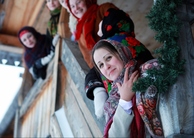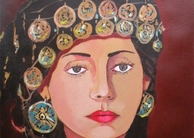From the Field:Rural-Urban Migration and Agricultural Transformation in India: Observing the Impact on Childhood Migration From Bihar to New Delhi
By
2013, Vol. 5 No. 10 | pg. 4/4 | « III. Perceptions of Rural versus Urban LifestylesWhen asking street children, both in NGOs and on the street, about what comes to mind when thinking about life in the city, descriptors tended to repeat: freedom, excitement, money. On the other hand, when we discussed the rural, many kids would describe it as poor, boring, and restrictive. Among children in Delhi and rural Bihar, there was a consistent perception that the urban environment was a busy, fun, and a great place to make more money. Working on farmlands at home was monotonous, unattractive, and lacked economic benefits. This sentiment extended into the style of those who had straddled both urban and rural environments, something Akhil Gupta notes in Postcolonial Developments. “Clothes made the man a villager or a city slicker. What a person wore signified not merely how wealthy he was but where he belonged as well” (Gupta 1998:85). Dress was crucial in distinguishing your status. Those who wore the traditional dhoti in Sitamarhi were viewed differently than those in Western business clothes, typically of a button down, collared shirt and slacks or jeans. The clothes carried with them a certain bravado that one was not permitted to access if they had never experienced the city. The men who returned to the villages from urban centers, many of which I met through the NGO Pratham had a swagger to themselves. One of our guides, Vikrant, who was twenty years old, ran away to many of the major cities years ago, but had since returned after being taken into the organization. At his home in Amritpur, his was no longer the child that left, but the man of the house. After experiencing the city, he was entitled to it. He was expected to provide for the family. It was indicative in both his dress and demeanor. Dressed in a clean, white button down and jeans, he stood out from other boys in his village, most of which were wearing ragged and tattered t-shirts and shorts. His movements, and the way in which he spoke to his kin, primarily his mother and older brother indicated his power within the family unit. Unlike his brother, who was a day laborer in the district town, Vikrant had gone to the city, earned, and decided to return. Earning and ideal occupation were two other factors that created a binary between the rural and urban landscapes. In the cities, one could earn more money in a short time span, doing work other than farming. There were more opportunities for social mobility in this situation than in the rural environment. More importantly, it was something other than farming, which seemed to garner a negative connotation among the young men in Amritpur. In the discussion, many of the men said they had no interest in farming or living in the village. Farming as a profession, they said, promised low wages, longer working hours, and less satisfaction. A few of them also expressed the view that farmers were uneducated as compared to people who worked in the city and had wage-based jobs.23 Going out of the village, at least for young men, had become a way in which to gain respect and increase one’s power within the village. It was a desirable trait, that when coupled with the connotations of a rural livelihood, seemed all the more attractive. Children, who are exposed to these perceptions, observing older men who return to the villages, see going to the city as something exciting, different, and a way to improve their socioeconomic status. Running away becomes a respected, realistic option for many children. ConclusionsAt a point in my fieldwork in Bihar, I grew intensely frustrated with the process. All of my neatly wrapped ideas and answers had been twisted, contorted, and bent into something barely resembling what I began with. I had to shift my framework and examine the issue from a new angle, to see running away as something outside of a fixed system. The complexities of youth migration in India stretch across multiple disciplines, spanning large swaths of not only physical landscape, but mental geography. It is not, and will never be a single-dimensional issue, but rather one riddled with paradox and contradiction. However, what is significant in making sense of this process is to see that one must embraces these intricacies, realizing the dense layers are part and parcel to the stories of running away. The agricultural transformations occurring in Bihar, and throughout large parts of India, are quite significant when one traces historical parallels.These events and histories are foundations to the contemporary state of agriculture and village life, contributing to instability, uneven growth and development, and ultimately the fracturing that permits such as pronounced system of running away for the rural youth. The life of a street child has much to do with the rural past, beginning long before the topic became a subject for social research. However, at the same time, one must realize developing histories and new concerns become inseparable pieces of these past histories, emerging hand and hand, not separately as a reason for running away. It is in these increasingly complex mazes and puzzles that a more human picture materializes, one that tells the story of running away as a reflection of a child’s past, goals, and hardships. ReferencesAcharyya, SK, Chakraborty, P., Lahiri, S., Raymahashay, BC, Guha, S., & Bhowmik, A. (1999). Arsenic poisoning in the Ganges delta. Nature, 401 (6753), 545-545. Ali, A. (1999). Climate change impacts and adaptation assessment in Bangladesh. Climate Research, 12, 109-116. Bhaskaran, Reshmi, & Mehta, Balwant. (2011). Surviving the Streets: A census of street children in Delhi by the Insitute for Human Development and Save the Children (pp. 84). New Delhi: Save the Children. Bhutta, Zulfiqar A., Black, Robert E., Cousens, Simon, & Ahmed, Tahmeed. (2008). Kwashiorkor and severe acute malnutrition in childhood ? Authors' reply. The Lancet, 371 (9626), 1749. Butterflies. (2011a). My Name is Today (Vol. 28, pp. 1-167). New Delhi Butteflies: Programme with Street & Working Children. Butterflies. (2011b). Situation of Street and Working Children in Delhi. from http://www.butterflieschildrights.org/working.php Chandran, R. V., Ramakrishnan, D., Chowdary, V. M., Jeyaram, A., & Jha, A. M. (2006). Flood mapping and analysis using air-borne synthetic aperture radar: A case study of July 2004 flood in Baghmati river basin, Bihar. Current Science, 90 (2), 249-256. Chaudhry, Praveen K. (1988). Agrarian Unrest in Bihar: A Case Study of Patna District 1960-1984. Economic and Political Weekly, 23 (1/2), 51-56. doi: 10.2307/4377953 Conticini, Alessandro. (2007). Children on the Streets of Dhaka. In J. Staples (Ed.), Livelihoods at the margins : surviving the city (pp. 272 p.). Walnut Creek, CA: Left Coast Press. Deshingkar, P. (2006). Internal migration, poverty and development in Asia: Including the excluded. IDS Bulletin, 37 (3), 88-100. FMIS. (2011, 2011). History of Flood. 2006, from http://fmis.bih.nic.in/history.html Ghosh, Shubham. (2012, December 13). Nitish Kumar leading Bihar, can neighbour Mamata learn?, oneindia news. Retrieved from http://news.oneindia.in/feature/2012/nitish-kumar-leading-bihar-can-neighbour-mamata-learn-1075606.html Harvey, C.F. (2002). Groundwater flow in the Ganges Delta. Science, 296 (5573), 1563-1563. Henderson, J. V. (2010). CITIES AND DEVELOPMENT. Journal of Regional Science, 50 (1), 515-540. doi: 10.1111/j.1467-9787.2009.00636.x Huberman, Jenny. (2006). Working and Playing Banaras: A Study of Tourist Encounters, Sentimental Journeys and the Business of Visitation. (Ph.D. Dissertation), University of Chicago. Karim, M.F., & Mimura, N. (2008). Impacts of climate change and sea-level rise on cyclonic storm surge floods in Bangladesh. Global Environmental Change, 18 (3), 490-500. Kumar, A., Tripathi, P., Singh, K. K., & Mishra, A. N. (2011). Impact of climate change on agriculture in eastern Uttar Pradesh and Bihar states (India). Mausam, 62 (2), 171-178. Kumar, A.K. Shiva. (2010). Population and Human Development: Contemporary Concerns. In A. K. S. Kumar, P. Panda & R. R. Ved (Eds.), Handbook of Population and Development in India (pp. 1-21). New Delhi: Oxford University Press. Kumar, Anand. (2008). Paradoxes of paradigm shift: Indian engagement with liberalization and globalization. Futures, 40 (8), 762-766. doi: http://dx.doi.org/10.1016/j.futures.2008.02.003 Mirza, M.M.Q., Warrick, RA, & Ericksen, NJ. (2003). The implications of climate change on floods of the Ganges, Brahmaputra and Meghna rivers in Bangladesh. Climatic Change, 57 (3), 287-318. Oberai, A. S., & Singh, H. K. Manmohan. (1980). Migration Flows in Punjab's Green Revolution Belt. Economic and Political Weekly, 15 (13), A2-A12. doi: 10.2307/4368516 Pandit, K. (2012). The Indian Landscape after Two Decades of Liberalization: An Introduction. Eurasian Geography and Economics, 53 (1), 1-6. Parliament, Indian. (2012). Right of Children to Free and Cumpulsory Education Act 2012. New Delhi: Retrieved from http://righttoeducation.in/sites/default/files/rte_amendment_act-2012.pdf. Sainath, Palagummi. (1996a). Crime & No Punishment Everybody Loves a Good Draught (pp. 263-264). New York: Penguin Books India. Sainath, Palagummi. (1996b). This is the Way We Go to School Everybody Loves a Good Drought (pp. 45-68). New York: Penguin Books India. Sakha, Bal. (2012). Sitamarhi Study (pp. 1). Patna: Bal Sakha. Sharma, Alakh N. (2005). Agrarian Relations and Socio-Economic Change in Bihar. Economic and Political Weekly, 40 (10), 960-972. doi: 10.2307/4416306 Shiva, Vandana. (1991). The Green Revolution in Punjab. The Ecologist 21 (2). Som, S., Pal, M., & Bharati, P. (2007). Role of individual and household level factors on stunting: A comparative study in three Indian states. Annals of Human Biology, 34 (6), 632-646. doi: 10.1080/03014460701671772 Steinberg, Jonah. (2012). Runaway Train: Railway Children and Normative Spatialities in India. Anthropology. University of Vermont. 1.) This description fails to give justice to the meticulous organization and skill required in collecting bottles. Children will keep track of exact arrival times of trains, positioning themselves on the tracks to hop on the train right when it arrives. The fastest pickers will be at the head of the train, while the slower ones are at the back, giving them more time before the train workers move through the cars. 2.) In Delhi, there was little intermingling between platform groups. Many times, platforms would refuse to speak with Khushboo and I due to the fact she was speaking with children from a platform they didn’t particularly like. 3.) While modernity can be defined differently depending on context, for the purposes of this paper, modernity refers to Western notions of technological progress and innovation that is many times conflated with development. 4.) There were a surprising number of people with mobile phones in Sitamarhi district. I spoke with children no older than ten who had mobile phones as well as grandparents who used their phone to speak with their children living in distant cities. I should note, as well, the cell phone service in Sitamarhi was the best I had had throughout all my research. 5.) Names of people and villages noted in this paper have been changed to protect identities. 6.) Hoja, who was 14 or 15, had recently dropped out of school to help her mother at home. She claimed her family was too poor, and her mother needed help taking care of her younger siblings. 7.) Unit of measurement commonly used in India that can vary considerably across regions. In Bihar, 2 to 3 bighas was about one acre. 8.) Interview with landowner, son of former zamindar, Sharma- July 24th, 2012 in Amritpur village, Sitmarhi district 9.) Conversation with villagers in tea shop, July 28, 2012, Amritpur, Sitamarhi district 10.) Historically lower scheduled caste, known as untouchables or dalits 11.) Interview conducted July 27th, 2012 in Baksampur village, Sitmarhi district with Chamar family 12.) Interview with landowner, son of former zamindar, Sharma- July 24th, 2012 in Amritpur village, Sitmarhi district 13.) Ibid. 14.) Conversation with villagers in tea shop, July 28, 2012, Amritpur, Sitamarhi district 15.) Interview conducted August 14th with Indu Prakash (IGSSS) in New Delhi 16.) Ibid. 17.) Defined as the practice of replanting the same crop species in the same field, with no break to a different crop 18.) In Jharkhand, a joint venture mining project between Indian and Canadian companies operated through accumulation by dispossession. First displacing the residents who were dependent on the land, the mining companies then offered jobs to many of the residents to work at the mine. However, the mine is only supposed to last for forty-five years, meaning “Godda will have a lot of people with no agriculture to fall back on and no jobs in Rajmahal” once the project has finished (Sainath, 1996a) (Sainath 1996a:264). While this type of development raises huge concerns for those living in Godda, Jharkhand and future livelihoods without agriculture, it is also alarming for Bihar, where no investment or funds are being funneled into. 19.) Discussion with young laborers in Amritpur village, Sitamarhi district, July 28, 2012 20.) Hindu Brahmin caste, that were historically landowners 21.) Interview with Bhumihar family, Baksampur village, Sitamarhi district, July 27th, 2012 22.) Ibid. 23.) Discussion with young laborers in Amritpur village, Sitamarhi district, July 28, 2012 Special thanks to Dr. Jonah Steinberg, Khushboo Jain, Salaam Baalak Trust, Indu Prakash, URECA!, APLE, and Kleinknect. Without the support of these people, organizations, and grants, this research would not have been possible. Suggested Reading from Inquiries Journal
Inquiries Journal provides undergraduate and graduate students around the world a platform for the wide dissemination of academic work over a range of core disciplines. Representing the work of students from hundreds of institutions around the globe, Inquiries Journal's large database of academic articles is completely free. Learn more | Blog | Submit Latest in Anthropology |














